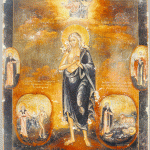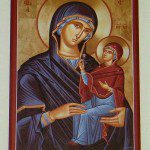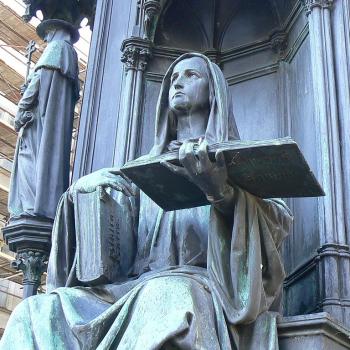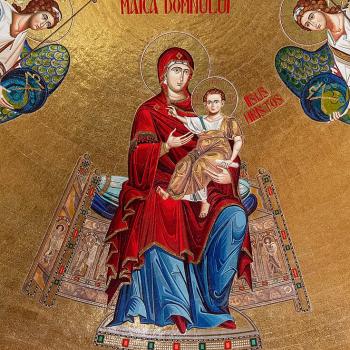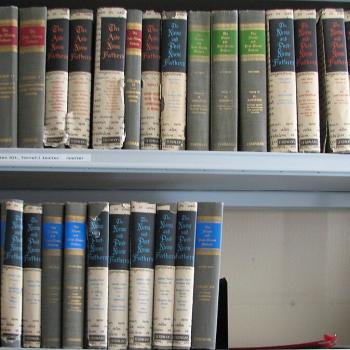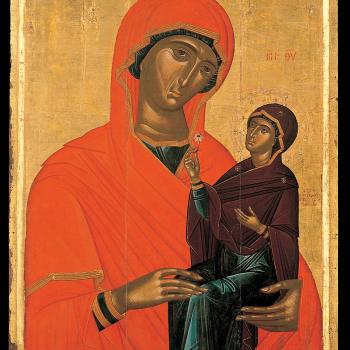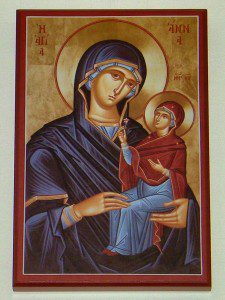
This is the third part of a series reflecting on Mary as Panagia, the All Holy One. Click here for Part I and click here for Part II.
Key to understanding Mary’s holiness, and the grace which was hers from the time of her conception onward, is to see how it came about through God’s long interaction with her family line. God was at work with Israel to prepare for the coming of the God-man, the messiah. That preparation included the development of the family line of the messiah, where grace was slowly but naturally infused by those who cooperated with God through the Law of Moses. With each application of grace, the family line slowly but surely edged closer and closer to achieving its purpose, which was the birth of the woman, the virgin, the sign of God and God’s grace in human history (cf. Isa. 7:14), who then, full of grace, could have the God-man dwell within her, and like the burning bush, not be consumed by the consuming-fire of God (cf. Heb. 12:29). Each of the ancestors of Christ brought particular graces into the line of Christ, grace which slowly accumulated with grace, so that at last Mary could be born, full of grace, receiving in her all the grace which had been established in her family line before her. In and through that grace, she was then free to make the decision for or against God, for our against God’s purpose for her, by accepting or denying her role in salvation history – for it is only in such perfect freedom could the God-man himself be born in such a way that God would remain true to himself – for God does not force himself upon us, but rather gives himself to us in an act of love awaiting our response (with Mary, then, representing the natural human answer to God). [1]
Just as the history of Israel is important, and in some ways represents the center of human history before the incarnation, we find that Jesus’ family line to be central to the history of Israel.[2] Jesus is the messiah, and as prophecy showed us, as the messiah he is the heir or son of David (cf. 2 Sam 7:12 -16). As with many prophecies, what was implied was not entirely clear in its proclamation but only revealed its full meaning through its fulfillment. Many, if not most, upon hearing it probably assumed that the prophecy was about one of David’s immediate successors, like Solomon, and believed that their messianic expectations would soon be fulfilled.[3] However, as prophecy often uses poetic language and historical types to prepare the way for their fulfillment, such a misunderstanding would be transcended once it became clear that such a messiah did not arise, making it possible for them to realize that it would be someone from David’s family line who would be placed upon the eternal messianic throne.
Nonetheless, because of the way prophecy uses historical figures to represent elements of its fulfillment, Solomon would, in some ways, represent the messianic king, even as Moses’ successor, Joshua, became a type of the messiah. Solomon built the temple, even as Jesus built the eternal temple, the church, the body of Christ. Solomon was full of wisdom, even as Jesus is wisdom incarnate. The Song of Songs was written based upon the love Solomon had with his beloved, while spiritually, the text refers to the love Christ has for us (collectively in the church as well as singularly in our soul).
We know that Jesus is understood to be the heir of David. Yet, how are we to recognize this, how are we to trace his lineage to David? Scripture, in its genealogies, seems to indicate such succession comes through Joseph and yet Joseph was not his real father. How then can Jesus be said to be the son of David? While we could, in theory, say that he was legally Joseph’s son, and so is connected to David’s line in a legal fashion, such an answer seems to be the easy way out, and indeed, seems to offer an unsatisfactory solution to the problem.
The traditional answer lies with the belief that Mary must also be descended from the line of David.[4] Is there any evidence we can give for this? Yes, said St John of Damascus:
But there was a law that one tribe should not marry into another. And Joseph, who was descended from the tribe of David and was a just man, for the holy Gospel testifies to this in his regard, would not have espoused the blessed Virgin illegally, but only if she were descended from the same tribe. Consequently, it was sufficient to show the descent of Joseph. [5]
The law which St John of Damascus referenced is found in the book of Numbers. It stated that women had to marry within their tribes if they wanted inheritance rights:
The inheritance of the people of Israel shall not be transferred from one tribe to another; for every one of the people of Israel shall cleave to the inheritance of the tribe of his fathers. And every daughter who possesses an inheritance in any tribe of the people of Israel shall be wife to one of the family of the tribe of her father, so that every one of the people of Israel may possess the inheritance of his fathers. So no inheritance shall be transferred from one tribe to another; for each of the tribes of the people of Israel shall cleave to its own inheritance (Num. 36: 7- 9 RSV).
Mary’s legal rights were protected only if she married someone within her tribe, not if she married someone outside of it. We know Joseph’s background, as the genealogies in the Gospels show. Since Mary and Joseph were betrothed to each other, they shared a common heritage, and this is what allows us to see how through Mary Jesus was the natural heir and successor of David. And this law was not something which was neglected or abandoned – rather, it was taken in all seriousness by Israel, as can be seen by the way Ezra reacted to those who had returned to Israel after the Babylonian Exile and failed to live up to its expectations:
After these things had been done, the officials approached me and said, “The people of Israel and the priests and the Levites have not separated themselves from the peoples of the lands with their abominations, from the Canaanites, the Hittites, the Perizzites, the Jebusites, the Ammonites, the Moabites, the Egyptians, and the Amorites. For they have taken some of their daughters to be wives for themselves and for their sons; so that the holy race has mixed itself with the peoples of the lands. And in this faithlessness the hand of the officials and chief men has been foremost.” When I heard this, I rent my garments and my mantle, and pulled hair from my head and beard, and sat appalled. Then all who trembled at the words of the God of Israel, because of the faithlessness of the returned exiles, gathered round me while I sat appalled until the evening sacrifice (Ezra 9:1-4 RSV).
The people repented. Those who had who married contrary to the Mosaic Law put their wives and children away (cf. Ezra 10:2-4; 7-44). While this might seem to be cruel, both to the wives and to the children alike, some, like Bede, suggested that these marriages were shown to be wrong because they were secondary marriages where the original wives of the exiles had been already been put away and were the real victims here.[6]
But, as with all things God does, God had a purpose, a reason, for is inclusion in the Mosaic Law, and so there was a purpose behind this aspect of the law as well. We must remember that while some of the Mosaic Law served to promote universal moral law, much of it was about the promotion and development of ritual purity for the people of Israel. That is, while we can find the moral law contained within the Mosaic Law, and so the Mosaic Law offers something for those outside of Israel, it also contained special laws meant only for those living out the Mosaic Covenant, laws which (as the Council of Jerusalem in the Acts of Apostles 15 makes clear) were not meant for all peoples at all times. They served a historical purpose, which is why they were good and true, but that purpose was the development of the lineage of the messiah, that is, the law and prophets pointed to and became the historical means by which the messiah would be born. They helped provide avenues of grace by which humanity could slowly work its way out of the pit of sin and become ready for the birth of the God-man, Jesus, as Robert Grosseteste explained:
For, as is clear from the foregoing, the positive precepts of the Old Law had been given for these reasons: so that they might test the humble obedience of man; so that they might crush his swelling pride, which was saying that he who acted was not at fault, but rather he who commanded was at fault; so that the complaint might be taken away by which the one who had fallen into the pit of sin was able to complain that he could not climb out by the rungs of the mandates of the natural law unless the rungs of the mandates of the positive law were inserted between them; and so that, as has been said, they might be signs and testimonies of our restoration. [7]
More to Come
[1] It is often asked by those who deny the teaching implied by the immaculate conception that if Mary had to be free from sin in order to give birth to Jesus, does that suggest that her parents, like her, had to be sinless in order for her to be born sinless from them? The answer is no. As should be clear, she was the sole source for Jesus’ humanity, while she had two sources for hers. When her parents came together, in grace, the higher levels of grace which was already in their individual lives was able to be combined together to establish a sinless conception, taking grace-filled qualities from both parents while not transmitting any impurity. She, on the other hand, had no mixture with anyone else to produce the fruit of her womb, Jesus, so all that Jesus had for his human nature and flesh came from one source, Mary. If there were any impurity left in her, it could and would have been transmitted to Jesus because there would be nothing to complement and overcome that impurity, unlike what happened with her conception in St. Anne. Nonetheless, we must remember, her parents, indeed, her immediate family (St. Elizabeth, St. John the Baptist, et. al.), were all extremely holy as a result of this accumulation of grace, so that, though her parents were not sinless, they were certainly extremely holy and lived lives close to natural human perfection.
[2] Israel is at the center because of its place in salvation history, for it was Israel God chose to represent him as a sign to the nations of the world, but also because God chose Israel as the people in which the God-man would be found. In this way, we must not deny God’s work with other nations, as some do, but rather see that they had God at work with them so that they can take their unique talents, insights and walk with God and merge it with Israel in the body of Christ.
[3] At this time, to be sure, the messianic expectation existed thanks to the Torah and Moses’ predictions, such as when Moses said, “The LORD your God will raise up for you a prophet like me from among you, from your brethren — him you shall heed “ (Deut. 18:15 RSV), but it was be later, with the prophets, that Israel’s understanding of the role of the messiah would be drastically increased.
[4] There is indication, from her cousins, that she was also descended from the Levites, but this would make perfect sense: the messiah is priest-king, and so combines both lineages in himself.
[5] St John of Damascus, “On the Orthodox Faith” in Saint John of Damascus Writings. trans. Fredric H. Chase Jr. (New York: Fathers of the Church, Inc., 1958), 362.
[6] See Bede, On Ezra and Nehemiah. trans. Scott DeGregorio (Liverpool: Liverpool University Press, 2006), 136-7.
[7] Robert Grosseteste, On the Cessation of the Laws. trans. Stephen M. Hildebrand (Washington, DC: The Catholic University of America Press, 2012), 90.
Stay in touch! Like A Little Bit of Nothing on Facebook:
A Little Bit of Nothing


